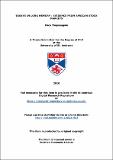Files in this item
Essays in long memory: evidence from African stock markets
Item metadata
| dc.contributor.advisor | McMillan, David G. | |
| dc.contributor.author | Thupayagale, Pako | |
| dc.coverage.spatial | 241 | en_US |
| dc.date.accessioned | 2010-05-26T11:22:43Z | |
| dc.date.available | 2010-05-26T11:22:43Z | |
| dc.date.issued | 2010-06-17 | |
| dc.identifier.uri | https://hdl.handle.net/10023/883 | |
| dc.description.abstract | This thesis explores various aspects of long memory behaviour in African stock markets (ASMs). First, we examine long memory in both equity returns and volatility using the weak-form version of the efficient market hypothesis (EMH) as a criterion. The results show that these markets (largely) display a predictable component in returns; while evidence of long memory in volatility is mixed. In general, these findings contradict the precepts of the EMH and a variety of remedial policies are suggested. Next, we re-examine evidence of volatility persistence and long memory in light of the potential existence of neglected breaks in the stock return volatility data. Our results indicate that a failure to account for time-variation in the unconditional mean variance can lead to spurious conclusions. Furthermore, a modification of the GARCH model to allow for mean variation is introduced, which, generates improved volatility forecasts for a selection of ASMs. To further evaluate the quality of volatility forecasts we compare the performance of a number of long memory models against a variety of alternatives. The results generally suggest that over short horizons simple statistical models and the short memory GARCH models provide superior forecasts of volatility; while, at longer horizons, we find some evidence in favour of long memory models. However, the various model rankings are shown to be sensitive to the choice of error statistic used to assess the accuracy of the forecasts. Finally, a wide range of volatility forecasting models are evaluated in order to ascertain which method delivers the most accurate value-at-risk (VaR) estimates in the context of Basle risk framework. The results show that both asymmetric and long memory attributes are important considerations in delivering accurate VaR measures. | en_US |
| dc.language.iso | en | en_US |
| dc.publisher | University of St Andrews | |
| dc.rights | Creative Commons Attribution-NonCommercial-NoDerivs 3.0 Unported | |
| dc.rights.uri | http://creativecommons.org/licenses/by-nc-nd/3.0/ | |
| dc.subject | Long memory | en_US |
| dc.subject | Volatility | en_US |
| dc.subject | Market efficiency | en_US |
| dc.subject | Structural breaks | en_US |
| dc.subject | Forecasts | en_US |
| dc.subject | Value-at-risk | en_US |
| dc.subject.lcc | HG5822.T5 | |
| dc.subject.lcsh | Stock price forecasting--Mathematical models | en_US |
| dc.subject.lcsh | Stock exchanges--Africa | en_US |
| dc.subject.lcsh | Capital market--Africa | en_US |
| dc.subject.lcsh | Risk management | en_US |
| dc.subject.lcsh | Financial futures | en_US |
| dc.title | Essays in long memory: evidence from African stock markets | en_US |
| dc.type | Thesis | en_US |
| dc.contributor.sponsor | Bank of Botswana | en_US |
| dc.type.qualificationlevel | Doctoral | en_US |
| dc.type.qualificationname | PhD Doctor of Philosophy | en_US |
| dc.publisher.institution | The University of St Andrews | en_US |
This item appears in the following Collection(s)
Except where otherwise noted within the work, this item's licence for re-use is described as Creative Commons Attribution-NonCommercial-NoDerivs 3.0 Unported
Items in the St Andrews Research Repository are protected by copyright, with all rights reserved, unless otherwise indicated.


